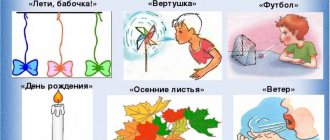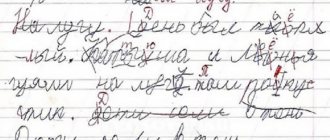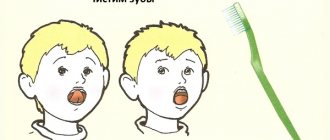The child does not pronounce hissing sounds: exercises for making hissing sounds, articulation gymnastics, tasks for children, video of a speech therapist.
Friends! Today I am pleased to introduce you in this article to speech therapist and defectologist Elena Shmygol. Today she will help you and your children learn how to speak hissing sounds correctly. And if you need Elena’s help, her individual Skype consultation, or you want to personally learn from her how to correctly do the exercises from the article with your child and teach your child to speak correctly with her help, then Elena’s contacts are given at the end of this article.
Correct pronunciation of the sound "sh":
When the sound is sh
pronounced correctly
- lips
are rounded and slightly extended forward; - the teeth
are close together, but not touching; - the tongue
takes the shape of a cup, its tip touching the tubercles behind the upper teeth (alveoli); the air stream is strong, warm, and comes out in the middle of the tongue.
Education w
and
z
differs only in the presence or absence of a voice, that is, the sounds
sh
and
z
are pronounced almost identically, only
sh
is voiceless, and
z
is voiced.
If a child has learned to pronounce the sound sh correctly ,
When you add a voice,
it
will work automatically.
“Home” speech therapy sound [w]
To teach your child to pronounce [w] correctly at home, you need to learn several basic methods of production:
- mechanical;
- from a similar-sounding sound.
Mechanical setting
With this method, the baby does not need to independently search for the correct position of the sound - an adult does this for him, using special speech therapy tools (spatula, probe). If you need to put your hand into a preschooler’s mouth, it must be clean.
Mechanical staging process
Staging through sound [r]
How to learn to say the letter Ш through the sound [r]? It would seem that incorrect pronunciation of [r] is the most complex and most common speech defect. However, many children know how to pronounce [r] correctly, but do not understand at all how to position the tongue in the mouth in order to whistle and hiss correctly. For this reason, the sound should be produced through a solid [r], and not adjacent sibilants.
The preschooler should sit in front of the mirror and pronounce [r], gradually weakening the air pressure. The sound should be pronounced until the vibration completely disappears. After this, a slight hiss will be heard and [w] will sound without the auxiliary [r].
Speech therapy exercises on pronunciation of the sound [sh]
To consolidate the placed [w] in the baby’s speech, it is necessary to speak as much as possible with a separate sound - hiss during the game. For this, the preschooler is offered various exercises:
- move the snake along the path, and hiss at the same time;
- “finish” a word, for example - small ..(sh), karanda ..(sh), etc.
Exercises for home practice on pronouncing the letter P for children
Disturbances in the pronunciation of hissing sounds in children:
First. The absence of hissing sounds in speech or their replacement with the sound t (instead of the word “bear” the child pronounces “mika”, instead of the word “thorn” the child pronounces “type” - replaces it with t).
Possible reasons for this distortion of the sh sound are early age or impaired phonemic hearing.
Second. Replacements with f (fifka - bump).
Possible causes of sound distortion:
violation of phonemic perception., too active lip work, shortened sublingual frenulum. This replacement is called labiodental sigmatism.
Third. Replacing the sound sh with the sound s (for example, instead of “went” the child pronounces “sla”). This replacement is called whistling sigmatism.
Possible reasons for sh sound distortion:
violation of phonemic awareness. When correcting, it is necessary to teach the child to distinguish between whistling and hissing sounds!
Fourth. Lisp. This is due to the fact that, in contrast to the normal position of the organs of articulation, the tongue is pushed between the upper and lower incisors, forming a flat gap with them, the back is lowered and does not form the back of the scoop. The air stream when you bring your palm to your mouth is weak and scattered.
Possible reasons for sh sound distortion:
shortened hyoid ligament, making it difficult to lift the tongue to the palate; high and narrow hard palate. This replacement is called interdental sigmatism.
Fifth. Lateral sigmatism.
In this case, in the words he pronounces, instead of the sound sh
a peculiar squelching sound is heard. One of the corners of the lips is slightly lowered or retracted, there may be a slight shift of the lower jaw to the left or right, the lateral edges of the tongue are also lowered. When you bring your palm to your mouth, the air stream goes to the side (left or right) or comes out along both edges of the tongue, while normally the air stream should go strictly in the middle of the tongue.
Possible causes of sound distortion:
weakness of the muscles of one half of the tongue; lateral open bite.
Sixth. Nasal sigmatism.
In this case, the sound w is replaced by snoring (in the nose) or a sound similar to the deep sound x with a nasal connotation. In contrast to normal articulation, the organs of speech occupy a neutral position, the tongue is lowered down and pulled into the depths of the mouth, the back of the tongue is raised up, connecting to the soft palate, the lateral edges are lowered down. The air stream exits through the nasal cavity and not from the mouth.
Cause of sound distortion
: is excessive tension on the back of the tongue.
Why doesn't the child pronounce the letter "sh"?
There are several reasons why a child has problems pronouncing the letter “sh”.
These include:
- Physiological - due to malocclusion, high palate, tongue size (too large or too small), shortened hyoid ligament, dentofacial abnormalities, disruption of the auditory canal.
- Developmental delays - when mental thinking, memory and attention are not fully formed - can lead to delayed speech development.
- Using a pacifier for a long time causes the bite to deteriorate, and some sounds (usually hissing and whistling) “suffer.”
- The manner in which parents communicate with their child – very often adults copy children’s speech and communicate with their child in a childish way, deliberately distorting words. As a result, the child hears only incorrect pronunciation and gets used to this manner of speaking.
- Parents initially speak incorrectly - they have some kind of speech defect, which the child repeats.
- Parents have excessively high demands - but at the same time they do not demonstrate to the child exactly how to speak correctly.
Don’t worry too much if your child can’t pronounce “sh”. Using the above methods, the defect can be corrected, and when the goal is achieved, this sound should be gradually introduced into the conversation so that the child encounters it as often as possible in everyday life. Then the sound “sh” will cease to be something difficult.
A complex of articulatory gymnastics for developing the correct pronunciation of hissing sounds
For articulation gymnastics you will need a mirror, cotton wool and... candy!
Each articulatory gymnastics exercise is performed 3-5 times for 5-10 seconds. The whole complex is done 3-5 times a day for 5-6 minutes .
You can watch the exercises of the complex performed in a demonstration by adults in the video of the “Spread your Wings” foundation.
Punish the naughty tongue. Open your mouth slightly, calmly place your tongue on your lower lip and, smacking it with your lips, pronounce the sounds five-five-five... Keep your wide tongue in a calm position, with your mouth open, counting from one to five to ten.
Make your tongue broad. Smile, open your mouth slightly, place the wide front edge of your tongue on your lower lip. Hold it in this position for a count of one to five to ten.
Glue on some candy. Place the wide tip of your tongue on your lower lip. Place a thin piece of toffee on the very edge of your tongue and glue a piece of candy to the roof of your mouth behind your upper teeth.
Fungus. Smile, show your teeth, open your mouth slightly and, pressing your wide tongue with its entire plane to the palate, open your mouth wide. (The tongue will resemble a thin mushroom cap, and the stretched hyoid ligament will resemble its stem.)
Who will kick the ball further? Smile, place the wide front edge of your tongue on your lower lip and, as if pronouncing the sound f for a long time, blow the cotton wool onto the opposite edge of the table.
Delicious jam. Open your mouth slightly and lick your upper lip with the wide front edge of your tongue, moving your tongue from top to bottom, but not from side to side.
Harmonic. Smile, open your mouth slightly, stick your tongue to the roof of your mouth and, without lowering your tongue, close and open your mouth (just as the bellows of an accordion stretch, so does the hyoid frenulum stretch). The lips are in a smiling position. When repeating the exercise, you should try to open your mouth wider and wider and keep your tongue in the upper position longer.
Focus. Smile, open your mouth slightly, place the wide front edge of your tongue on your upper lip so that its side edges are pressed together and there is a groove in the middle of your tongue, and blow off the cotton wool placed on the tip of your nose. The air should go in the middle of the tongue, then the fleece will fly up.
Cup. After the child learns to spread his tongue and make it wide, has mastered the tasty jam exercise, offer him: “Open your mouth slightly, make a cup out of your tongue, like I did, and place it on the tubercles behind the upper teeth. Now blow on your tongue. Do you hear how the wind rustled? Air passing through a small gap between the front edge of the tongue and the palate produces the sound sh.
Tongue twisters for sibilants
Activities that parents will conduct with their child in a playful way, including reading or memorizing tongue twisters for hissing sounds, can help in the formation of correct articulation. They are perceived quite simply.
Repeating tongue twisters can be turned into a fun competition for speed, in which parents and children will have equal conditions. Thus, special expressions will teach the baby the correct pronunciation. Parents can purchase books with tongue twisters or use examples provided on the Internet.
Songs for sound automation
I decided to make a small addition to Elena’s article. I love music very much, and therefore I always like to sing with children in my classes. Children enjoy repeating words with the desired sound many times in songs. Therefore, I have selected simple songs with the sound Sh for you and your children.
Start with songs in which you only need to pronounce syllables with the sh sound. Next, use songs with words that contain the sound Ш. Let the child finish and sing along these words from the text. And when he already speaks the sound Ш well enough, you can use tongue twisters or complex songs (for example, the song “Horses”).
Song - a pure saying for automating the correct pronunciation of the sound Ш in syllables
Shi-shi-shi-shi, how good the candies are, Sho-sho, sho-sho, wash your hands well, Shu-shu, shu-shu, I’ll invite you to the table, Sha-sha, sha-sha we’ll eat slowly.
Song "Horses"
In the song we automate the correct pronunciation of the sound Ш in phrases.
Consolidation
After the child has managed to pronounce the sound “sh”, it is important to consolidate the result and automate the process.
For this purpose, a special task file
for every baby.
You need to start with simple words and phrases
in which problematic sounds are often found.
You can also keep a special home notebook to consolidate
the results, where children, starting from
the 1st grade,
will be able to write down
texts
with abundant content of the letter “w”.
It is necessary that the child not only phonetically
correctly pronounced the sound “sh”, but also used it correctly in
grammar
. If the letter is written and used correctly, the baby will try to use it correctly in conversation.
In such a notebook, you need to give the task of adding endings in the words: Nata...(sha) pi...(shet), Timo...(sha) wants to eat...(sha), Ma...(sha) collects lands...(shi).
You need to teach your child to create a diminutive form of words: uncle - uncle, crumb - crumb, ear - ear, spot - spot.
Expert opinion
Margarita Sergeevna S.
Speech pathologist and speech pathologist with 15 years of experience working in various speech correction centers with children of different ages.
You should compose a text where the letter “w” appears constantly; words should be replaced with pictures. When reading, the child will try to pronounce the words correctly. It is important to maintain an entertaining component for the baby, then he will perceive the activities as a game.
There is a wide selection of poems
and
pure tongues
, which are aimed at establishing the sound “sh” in children.
Expert opinion
Margarita Sergeevna S.
Speech pathologist and speech pathologist with 15 years of experience working in various speech correction centers with children of different ages.
The child should also be able to correctly use the letter “w” in spelling. To do this, he needs to make sentences with problematic sounds. You can start with simple monosyllabic sentences, gradually complicating the task.










